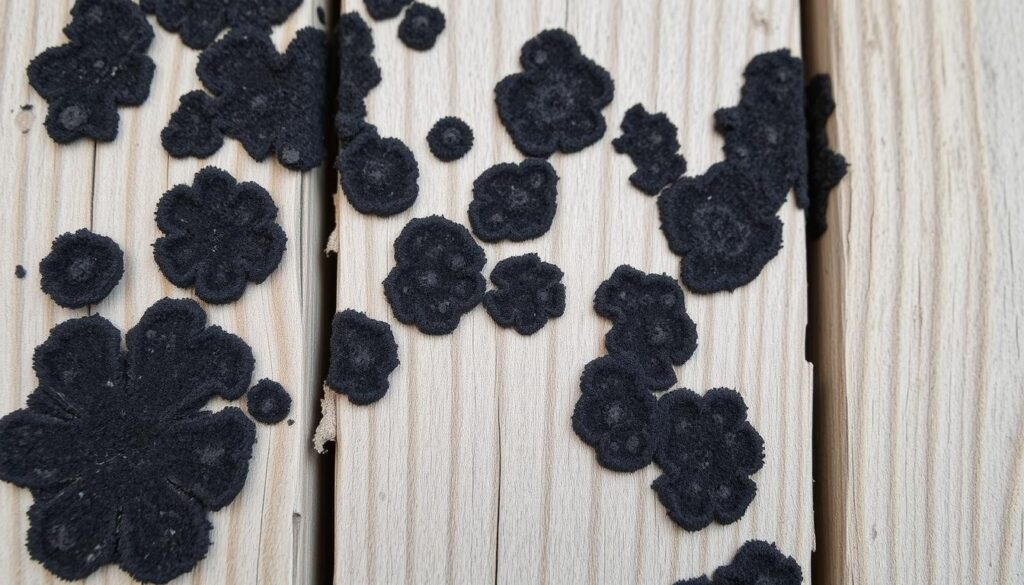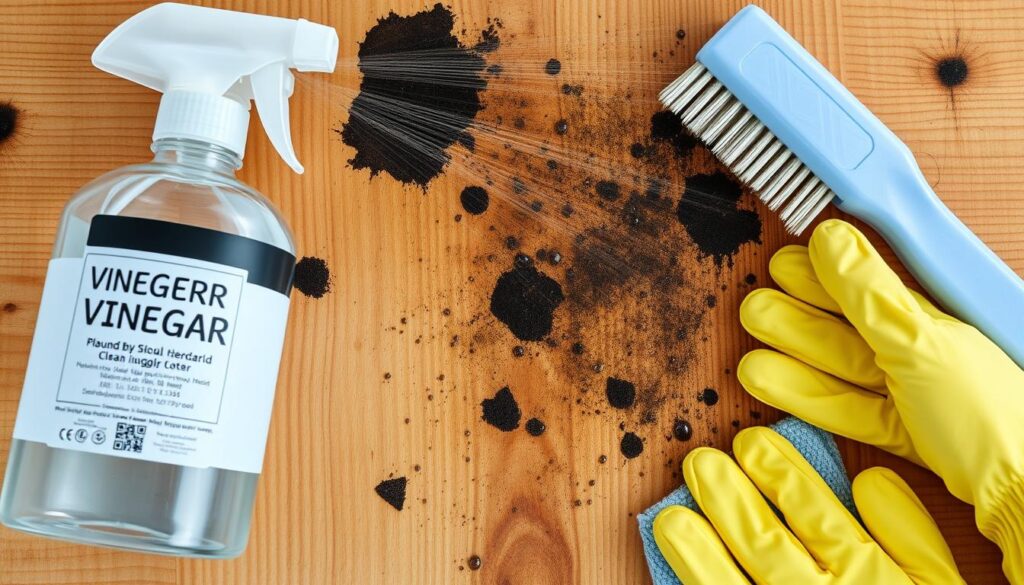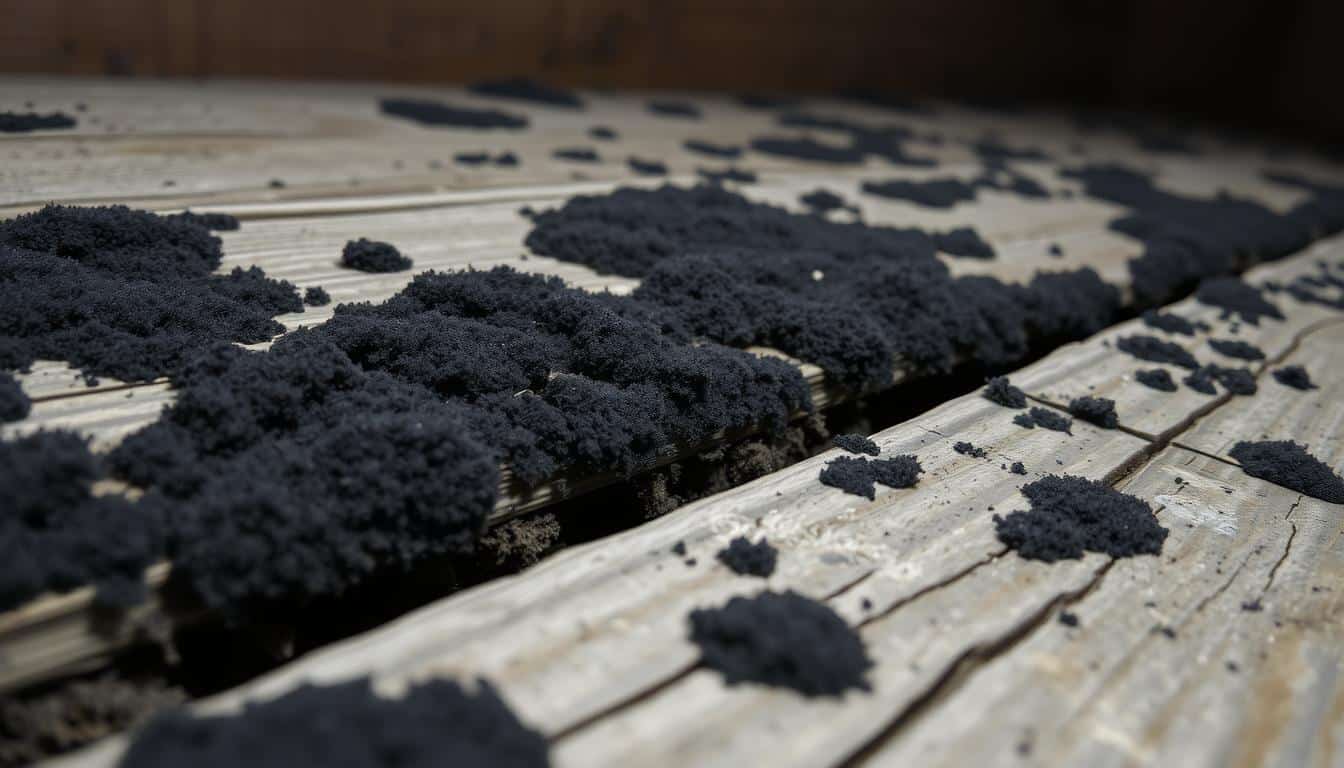There are about 180 types of aspergillus mold, and some can cause a serious lung disease called aspergillosis. This disease is especially dangerous for people with weak immune systems. Black mold, or Stachybotrys chartarum, is even more dangerous. It can harm your health and property, causing breathing problems, allergies, and serious health issues.
In this guide, I’ll show you how to remove black mold from wood and prevent it from coming back. For small amounts of mold, you might use white vinegar or hydrogen peroxide. But for bigger problems, you need a professional. They can safely remove the mold and find out why it started in the first place.
Key Takeaways
- Black mold, scientifically known as Stachybotrys chartarum, poses significant risks to both property and health.
- Exposure to black mold spores can trigger respiratory problems, allergies, and severe health issues.
- Home remedies can be effective for small-scale black mold growth on wood, but professional mold remediation is often necessary for larger infestations.
- Professionals can assess the extent of the mold problem, ensure safe removal, and address the underlying moisture issues.
- Mold on wooden surfaces is particularly challenging to remove due to the porous nature of wood, requiring thorough cleaning techniques.
Understanding the Dangers of Black Mold on Wood
Black mold is more than just a nuisance; it’s a serious health risk and can damage your home. This fungus grows well in damp places and harms wood over time. It can cause wood decay and weakening. Exposure to black mold spores can lead to health problems, from breathing issues to allergies and severe conditions.
Health Risks of Exposure to Black Mold
Inhaling black mold spores can harm your health. It can cause respiratory problems like coughing and wheezing. It may also trigger allergies and eye irritation. In severe cases, it can lead to chronic fatigue, lung disease, memory loss, and even cancer.
Structural Damage Caused by Black Mold on Wood
Black mold on wood can damage your home’s structure. It eats away at the wood, causing it to decay and weaken. This can make your home unsafe and lead to expensive repairs.
“Mold growth can manifest as black spots, green streaks, or white discoloration on wood, and it typically exhibits a fuzzy or velvety texture in areas with high humidity or moisture levels.”
It’s crucial to spot and treat black mold on wood to keep your home safe. By understanding the dangers of black mold and acting early, you can protect your home and family’s health.
Identifying Black Mold on Wood Surfaces
Mold can be a big problem on wooden surfaces. It’s important to know what kind of mold you have. Black mold is especially dangerous because it can harm your health and damage your home if not treated.
Common Signs of Black Mold Growth
Here are some signs you might have black mold on your wood:
- Black, green, gray, white, or red patches that appear fuzzy or slimy in texture
- Thread-like growth patterns on the wood surface
- A musty or damp odor emanating from the affected area
Distinguishing Mold from Other Discoloration
Mold doesn’t always look like the typical green and fuzzy growth. It can be hard to tell mold apart from other wood discolorations like dirt, rot, or water stains. To spot mold, look for:
- Uniform color and texture of the suspected mold, unlike the irregular patterns of wood grain
- Rapid growth and spread of the affected area, unlike the more gradual changes seen in natural discoloration
- A musty, damp odor that can indicate the presence of active mold growth
When dealing with black mold, it’s best to be cautious. Always have a professional check the area to make sure it’s safe to remove.

DIY Methods for Removing Black Mold from Wood
Removing black mold from wood can seem tough, but it’s doable with the right tools and steps. You can safely remove mold from floors, ceilings, or furniture. These DIY methods are efficient and safe.
Cleaning Solutions for Tackling Mold on Wood
Home remedies and cleaning solutions can tackle small black mold growth on wood. Some top choices include:
- White vinegar – Its acidity kills mold spores and stops them from growing back.
- Hydrogen peroxide – This natural cleaner can get rid of black mold on wood.
- Baking soda – Mixed with water, it makes a paste that scrubs away mold from wood.
While DIY solutions work for small mold issues, experts are needed for big problems. Mold remediation pros have the skills and tools to safely remove mold. They prevent spores from spreading in your home.
Step-by-Step Guide for Removing Mold from Wood
If you’re up for the diy black mold removal wood challenge, here’s how to do it right:
- Put on protective gear like a respirator mask, rubber gloves, and safety goggles.
- Clean the area with a cleaning solutions for moldy wood like vinegar or hydrogen peroxide.
- Scrub the wood with a stiff brush to remove any visible mold.
- Rinse the area with clean water and let it dry completely.
- Apply a mold-resistant sealant or paint to prevent future step-by-step mold removal from wood.
Remember, good ventilation and controlling moisture are key to stopping mold from coming back. By following these steps, you can remove black mold from wood and make your home healthy and mold-free again.
how to remove black mold from wood
Dealing with black mold on wood needs careful steps and the right tools. Spotting mold early is key to avoid damage and health issues. Whether it’s on outdoor furniture, decking, or siding, or indoor wood, a detailed cleaning is vital.
First, get your cleaning supplies ready. You’ll need bleach (use with care), a bucket, strong vinegar, microfiber cloths, a mold cleaner or dish soap, sandpaper, a brush, and a vacuum with a HEPA filter. Mold is harder to remove from wood than from hard surfaces. Start with milder products and move to stronger ones if needed.
- Check how big the mold area is. If it’s over 10 square feet, call a mold removal expert.
- Wear goggles, gloves, and a mask to protect yourself from mold spores.
- Use a mold cleaner or a water and dish soap mix to clean the mold. Focus on corners and hard spots.
- If mold stains don’t go away, try a vinegar or hydrogen peroxide solution. They work well on wood.
- Dry the area well and sand it if stains remain. This helps remove stains.
- Throw away all cleaning stuff and vacuum with a HEPA filter to catch mold spores.
To stop mold from coming back, control moisture and air well. Regularly clean and check wood surfaces to keep them mold-free and safe.

| Method | Effectiveness | Safety Considerations |
|---|---|---|
| Bleach | Works well, but can harm wood and release harmful fumes | Use with extreme caution and ensure proper ventilation |
| Vinegar | Very effective, safe for wood | Wear gloves and work in a well-ventilated area |
| Hydrogen Peroxide | Works well on porous wood | Wear gloves and work in a well-ventilated area |
| Borax | Works on treated, non-porous wood | Wear gloves and work in a well-ventilated area |
Removing black mold from wood requires thorough cleaning, safety, and ongoing care. By acting fast and using the right methods, you can keep your wood safe and healthy.
Removing Black Mold from Hardwood Floors
Hardwood floors are a timeless and beautiful choice for homes. But, they can get black mold if not kept up well. Black mold, or Stachybotrys chartarum, grows in damp, warm places. It can cause health problems, especially for those with weak immune systems or lung issues.
If you think you have black mold on your hardwood floors, act fast. The steps for cleaning mold from other surfaces work for hardwood too. But, be careful with hardwood since mold can damage it if it goes deep.
- Check the mold spot closely. If the wood feels soft when you press it with a screwdriver, it might be okay with cleaning. But, if it feels crumbly, the mold has damaged it too much, and you’ll need to replace the flooring.
- Clear the area of any furniture or rugs. Wear gloves, goggles, and a mask to protect yourself from mold spores.
- Use a mold-killing solution or a bleach and water mix to clean the mold. Always follow the instructions and make sure the room is well-ventilated.
- After removing the mold, dry the area well to stop it from coming back. You might need fans or dehumidifiers to dry the floor completely.
- If the mold has really damaged the wood, sand and refinish it to fix its look and strength.
To stop black mold from coming back on hardwood floors, keep humidity levels between 30% and 50%. Fix any moisture problems right away. Regular cleaning and care of your hardwood floors can also help prevent mold.
If mold keeps coming back or seems bad, get help from a mold removal expert.
| Mold Type | Health Risks | Damage to Wood |
|---|---|---|
| Aspergillus | Respiratory problems, especially in those with weakened immune systems | Can break down wood structure, causing rot |
| Stachybotrys chartarum (Black Mold) | Respiratory problems, headaches, skin rashes | Can cause significant damage to wood, leading to structural issues |
“The species of mold is less relevant than the extent of exposure when considering health problems caused by mold.”- Centers for Disease Control and Prevention
By quickly dealing with black mold on hardwood floors and taking steps to prevent it, you can keep your floors beautiful and healthy.
Tackling Black Mold on Wooden Ceilings
Removing black mold from wood ceilings can seem tough, but it’s doable with the right steps. Black mold, or Stachybotrys chartarum, often grows on wood in damp places. It thrives in humid or moist areas.
First, find out why the mold is there. Mold usually grows because of too much moisture. This can come from leaks, bad ventilation, or too much humidity. Fixing the moisture issue is key to stopping mold.
When cleaning moldy ceilings, safety comes first. Black mold can harm your health, causing breathing problems and allergies. Always wear a mask, gloves, and goggles. Work in a place with good air flow to avoid breathing in mold spores.
For small mold spots, you can clean them yourself. Mix water with detergent or water, bleach, and detergent to kill the mold. Use a soft brush to gently scrub the mold, then rinse well.
But, if the mold is big or has been there for a long time, get help from experts. Mold remediation pros have the tools and know-how to safely remove mold. They can also prevent more damage and health risks.
Preventing mold is just as important as removing it. Good air flow, controlling moisture, and regular cleaning keep wood ceilings healthy. Quick action and the right steps can keep your ceilings safe and looking good.
| Mold Removal Cost | Mold Inspection Cost |
|---|---|
| $1,125 – $3,439 | $648 (average) |
The EPA says you can tackle small mold spots yourself. But for bigger areas or ongoing mold, get a pro. They ensure the mold is fully removed and won’t come back.
Preventing Future Black Mold Growth on Wood
Getting rid of black mold on wood is just the start. It’s also key to fix the issues that caused it in the first place. By managing moisture and humidity, and making sure there’s good air flow and insulation, you can make your home less welcoming to mold. These steps can help a lot in preventing black mold on wood and keeping your home safe.
Controlling Moisture and Humidity
Mold loves damp, humid places. So, it’s important to keep your home dry. Look for and fix any leaks or extra moisture, like in bathrooms or kitchens. Use dehumidifiers to keep humidity between 30-50%.
Also, think about installing fans in wet areas. Good insulation helps control humidity and stops moisture from building up on wood.
Proper Ventilation and Insulation
Good air flow is essential to stop mold. Make sure your home breathes well, with open windows and vents. Also, your HVAC system should work right.
Insulation is important too. It keeps warm air in winter and cool air in summer. This reduces moisture on wood.
“Immediate action is key to prevent mold growth when a leak occurs, with chances of mold growth reduced if affected materials are dried within a day or two.”
By being proactive about moisture and air flow, you can lower the chance of mold coming back. These steps will protect your home and keep it mold-free.
| Mold Remediation Tips | Key Considerations |
|---|---|
| Controlling Moisture and Humidity |
|
| Proper Ventilation and Insulation |
|
When to Seek Professional Help
As a homeowner, it’s important to watch for black mold on wood surfaces. You can handle small mold problems yourself. But, big infestations or damage need professional mold remediation specialists.
If you see black mold or lots of discoloration on wood, call the experts. They can check and remove mold safely. Mold experts have the right tools and know-how to get rid of mold without spreading it.
Here are signs you need professional mold remediation:
- Mold covering more than 2 square feet
- Mold on wooden beams or joists
- Musty smells or moisture damage
- Health problems like breathing issues or allergies
Trying to fix big mold problems yourself can be dangerous. It might spread mold and make things worse. By calling in the experts for black mold on wood, you get a safe and complete fix. This protects your home and family.
| Mold Remediation Considerations | DIY Mold Removal | Professional Mold Remediation |
|---|---|---|
| Mold Growth Size | Under 10 square feet | Over 2 square feet |
| Health Risks | Low to moderate | Moderate to high |
| Cost | $50 – $200 | $1,000 or more |
| Completion Time | 1-2 days | 1-3 days |
“Mold remediation professionals have the knowledge, experience, and specialized equipment to safely and thoroughly remove black mold from wood without spreading spores throughout your home.”
Conclusion
Removing black mold from wood surfaces needs a detailed plan. DIY methods work for small mold spots. But, it’s important to know the risks and be careful.
For big mold problems or when your family’s safety is at risk, call in the pros. Mold remediation experts have the right tools and know-how. They make sure the area is clean, disinfected, and safe.
Keep an eye out for mold signs early and act fast. This way, you protect your wood and keep your family healthy. The main points are to fix the mold cause, clean well, and keep moisture under control.
FAQ
What are the common signs of black mold growth on wood surfaces?
Signs of black mold on wood include black, green, gray, white, or red patches. You might also see a fuzzy or slimy texture. Thread-like growth and a musty smell are other indicators.
How can I distinguish black mold from other wood discoloration?
Mold growth is usually uniform in color and texture. This is different from wood grain. Check any suspected mold spots closely, as they may not always look green and fuzzy.
What DIY cleaning solutions can I use to remove black mold from wood?
For small black mold growth, you can try home remedies. White vinegar, hydrogen peroxide, and baking soda are effective.
When should I call in professional mold remediation experts?
If you have a lot of black mold on wood, get professional help. Experts have the right tools and knowledge to safely remove mold without spreading spores.
How can I prevent future black mold growth on my wood surfaces?
To stop mold, control moisture and humidity. Make sure your home is well-ventilated and insulated. Also, fix any issues that cause mold growth.




